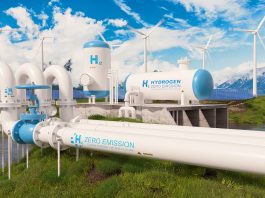As the world grapples with the urgent need to decarbonise various sectors and transition toward a more sustainable energy landscape, the potential of renewable hydrogen as a clean energy source is garnering significant attention.
Derived from water through electrolysis, renewable hydrogen presents a compelling solution to energy storage challenges, emissions reduction, and the integration of variable renewable energy sources like wind and solar.
However, the path to a hydrogen economy is fraught with technical and economic hurdles, including high production costs and infrastructural inadequacies.
Innovation News Network explores the role of renewable hydrogen in accelerating the energy transition and how overcoming these challenges could catalyse a worldwide shift towards a cleaner, more resilient energy future.
The potential of renewable hydrogen
The untapped potential of clean hydrogen in revolutionising the energy sector is vast, promising significant advantages for decarbonisation efforts across many industries. As a versatile energy carrier, clean hydrogen can play a crucial role in decarbonising sectors where direct electrification is challenging.
Most of the world’s hydrogen is produced using fossil fuels, contributing to global emissions. However, with technological advancements, clean hydrogen produced from renewable energy sources can provide a sustainable alternative. In addition to being a clean energy source, hydrogen can be stored and transported, enabling energy security and resilience.
Despite these potentials, clean hydrogen is currently more expensive than its fossil-fuel-derived counterparts. The cost challenges can be mitigated by imposing greenhouse gas emission pricing for grey hydrogen, thereby enhancing the competitiveness of clean hydrogen. Also, economies of scale and technological improvements are expected to reduce costs over time.
Challenges in hydrogen production
What are the primary obstacles that must be overcome to boost clean hydrogen production? The first major hurdle is the high carbon footprint of current hydrogen production methods. Approximately 98% of hydrogen is produced using natural gas and coal, contributing to around 3% of the world’s total CO2 emissions. The shift to renewable sources for hydrogen production is necessary, yet challenging, to meet the Paris Agreement targets.
The second obstacle is cost. Green hydrogen is significantly more expensive than grey hydrogen, produced using fossil fuels. Even though the costs of green hydrogen production are projected to fall, achieving cost competitiveness remains a significant challenge.
Lastly, the execution of green hydrogen projects is a concern. While many projects are announced, few reach completion due to the high capital investment needed and uncertainties in market demand for green hydrogen. Guaranteeing investors that there will be a green hydrogen market is pivotal for these projects’ success. Overcoming these challenges will be crucial in harnessing the full potential of clean hydrogen in accelerating the energy transition.
Making hydrogen affordable
Affordability is pivotal in propelling hydrogen’s widespread adoption as a clean energy source. Green hydrogen production is costly compared to its fossil fuel-derived counterpart, grey hydrogen. This cost disparity is primarily due to the capital-intensive nature of green hydrogen production, which requires significant renewable power.
However, the future outlook is promising, with green hydrogen costs projected to fall considerably by 2030 due to technological advancements and economies of scale. Policy initiatives such as imposing greenhouse gas emission pricing for grey hydrogen could further level the playing field.
This transition to affordable green hydrogen isn’t just about reducing emissions. It’s about shaping a sustainable future for all. Governments, industry, and consumers must work together to ensure this clean energy source becomes viable and affordable.
Implementation of green hydrogen projects
While making green hydrogen affordable is crucial, the successful implementation of green hydrogen projects across the globe is equally important. To meet the Paris Agreement targets, we need to increase the production of green hydrogen by 75-fold by 2030. But this isn’t as easy as it sounds.

Green hydrogen production is capital-intensive and requires substantial renewable power. The annual production of a million tonnes of green hydrogen needs 10 gigawatts of electrolysers, 20 gigawatts of renewable power generation, and $30bn in investment.
However, only a few green hydrogen projects have passed the planning stage. The primary risk is offtake – guaranteeing that the green hydrogen produced will find buyers. Currently, the cost of green products like green ammonia is significantly higher than their fossil fuel counterparts, and demand is low.
Overcoming these hurdles will require innovative solutions, strong regulatory frameworks, and risk mitigation instruments. With the World Bank Group’s support, developing countries can prepare for and implement green hydrogen projects, paving the way for a cleaner, more sustainable future.
The World Bank’s role in the hydrogen transition
In the global push towards a hydrogen-based energy transition, the World Bank Group’s role is pivotal. As a key player in international finance, the World Bank is uniquely positioned to catalyse the development and deployment of renewable hydrogen technologies, particularly in developing economies.
The World Bank already provides upstream project preparation support in Brazil, Chile, India, Mauritania, and Namibia. Through mechanisms such as competitive auctions, feed-in tariffs, and contracts for difference, the World Bank is helping these countries to create enabling frameworks and risk mitigation instruments.
Furthermore, the World Bank is fostering capacity-building and regulatory solutions, business models, and technologies for the rollout of low-carbon hydrogen. Through the Hydrogen for Development initiative, the Bank aims to catalyse significant financing for hydrogen investments from public and private sources.










